Fitness apps have revolutionized the way individuals approach their health and workout routines by offering a blend of tracking, motivation, and community support. With features like activity tracking, nutrition logging, and personalized workout plans, these apps cater to diverse fitness goals and preferences. By integrating with wearable devices, they enhance user experience and foster a sense of accountability and connection among users.
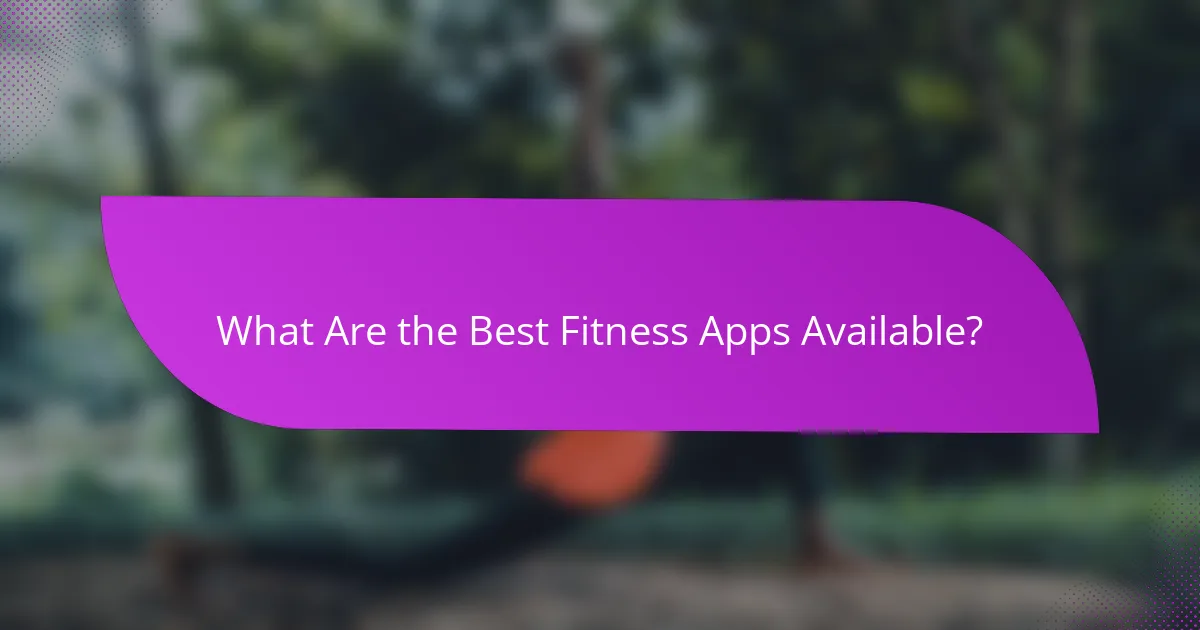
What Are the Best Fitness Apps Available?
The best fitness apps combine tracking, motivation, and community support to enhance your workout experience. Popular options include MyFitnessPal, Strava, Fitbit, Apple Fitness+, and Google Fit, each offering unique features tailored to different fitness goals.
MyFitnessPal
MyFitnessPal is primarily a nutrition tracking app that helps users monitor their calorie intake and macronutrient balance. It boasts a vast database of foods, making it easy to log meals and track dietary habits.
In addition to food tracking, MyFitnessPal allows users to integrate exercise data, providing a comprehensive view of their health. The app offers community features, enabling users to connect with friends for motivation and support.
Strava
Strava is a favorite among runners and cyclists, focusing on activity tracking and social networking. Users can record their workouts using GPS, analyze performance metrics, and share achievements with a community of athletes.
Strava’s unique segments feature allows users to compete on specific stretches of road or trail, adding a competitive edge to workouts. The app also offers challenges and leaderboards to keep users engaged and motivated.
Fitbit
Fitbit is both a fitness app and a wearable device ecosystem that tracks various health metrics, including steps, heart rate, and sleep patterns. The app syncs with Fitbit devices, providing real-time data and insights into overall wellness.
Fitbit encourages users to set goals and offers reminders to stay active throughout the day. The app also includes guided workouts and challenges to foster a sense of community among users.
Apple Fitness+
Apple Fitness+ is designed for Apple device users, offering a subscription-based service that provides access to a wide range of workout classes. Users can choose from various activities, including yoga, strength training, and HIIT, all led by professional trainers.
The app integrates seamlessly with Apple Watch, allowing users to track their metrics in real-time during workouts. This integration enhances motivation by displaying performance stats on-screen while exercising.
Google Fit
Google Fit is a versatile fitness app that tracks physical activity and health metrics using data from various devices and apps. It focuses on heart points and move minutes, encouraging users to meet daily activity goals.
Google Fit allows for integration with other health apps, providing a holistic view of wellness. The app is user-friendly and offers personalized recommendations based on activity levels, making it suitable for users of all fitness levels.
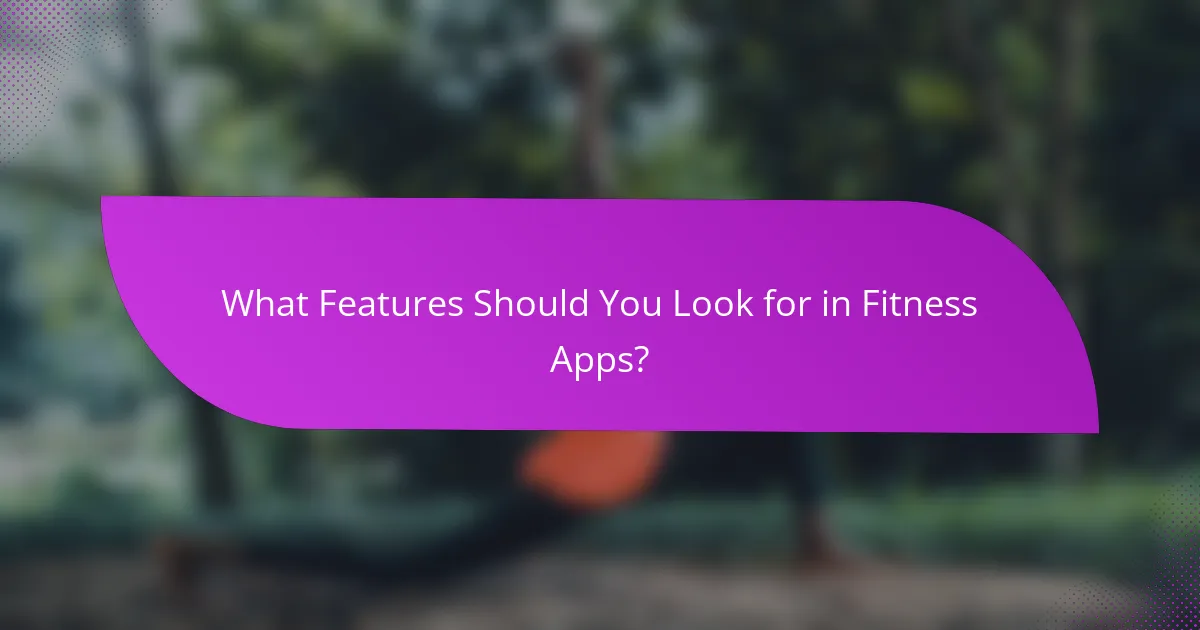
What Features Should You Look for in Fitness Apps?
When selecting a fitness app, prioritize features that enhance your workout experience and help you achieve your health goals. Key functionalities include activity tracking, nutrition logging, personalized workout plans, social sharing capabilities, and integration with wearable devices.
Activity Tracking
Activity tracking is essential for monitoring your physical movements and progress over time. Look for apps that can log various exercises, steps taken, and calories burned, providing a comprehensive overview of your daily activity. Many apps offer GPS tracking for outdoor activities, which adds accuracy to your data.
Consider apps that allow you to set goals and receive reminders to stay active. Some popular options provide visual progress reports, which can motivate you to maintain or increase your activity levels.
Nutrition Logging
Nutrition logging helps you keep track of your dietary intake, making it easier to meet your fitness goals. Choose apps that offer extensive food databases, barcode scanning, and the ability to log meals quickly. This feature can help you understand your calorie consumption and nutrient balance.
Some apps provide personalized meal suggestions based on your dietary preferences and goals, which can be particularly useful for those following specific diets like keto or vegan. Regularly logging your meals can lead to better eating habits and improved overall health.
Workout Plans
Personalized workout plans are crucial for tailoring your fitness routine to your individual needs. Look for apps that offer customizable plans based on your fitness level, available equipment, and specific goals, such as weight loss or muscle gain. Many apps include video demonstrations to ensure proper form.
Additionally, consider apps that adapt your workout plans based on your progress, keeping your routine challenging and engaging. This adaptability can help prevent plateaus and maintain motivation over time.
Social Sharing
Social sharing features allow you to connect with friends and fellow fitness enthusiasts, fostering a sense of community. Look for apps that enable you to share your achievements, participate in challenges, and encourage others. This social aspect can enhance motivation and accountability.
Some apps offer leaderboards and group challenges, which can make workouts more fun and competitive. Engaging with others can also provide support and tips, enriching your fitness journey.
Wearable Integration
Wearable integration is important for syncing data from devices like smartwatches and fitness trackers. Choose apps that seamlessly connect with popular wearables, allowing for automatic data transfer and more accurate tracking of your workouts and health metrics.
Integration with wearables can enhance the functionality of fitness apps by providing real-time heart rate monitoring, sleep tracking, and more. This comprehensive data can help you make informed decisions about your fitness and health strategies.
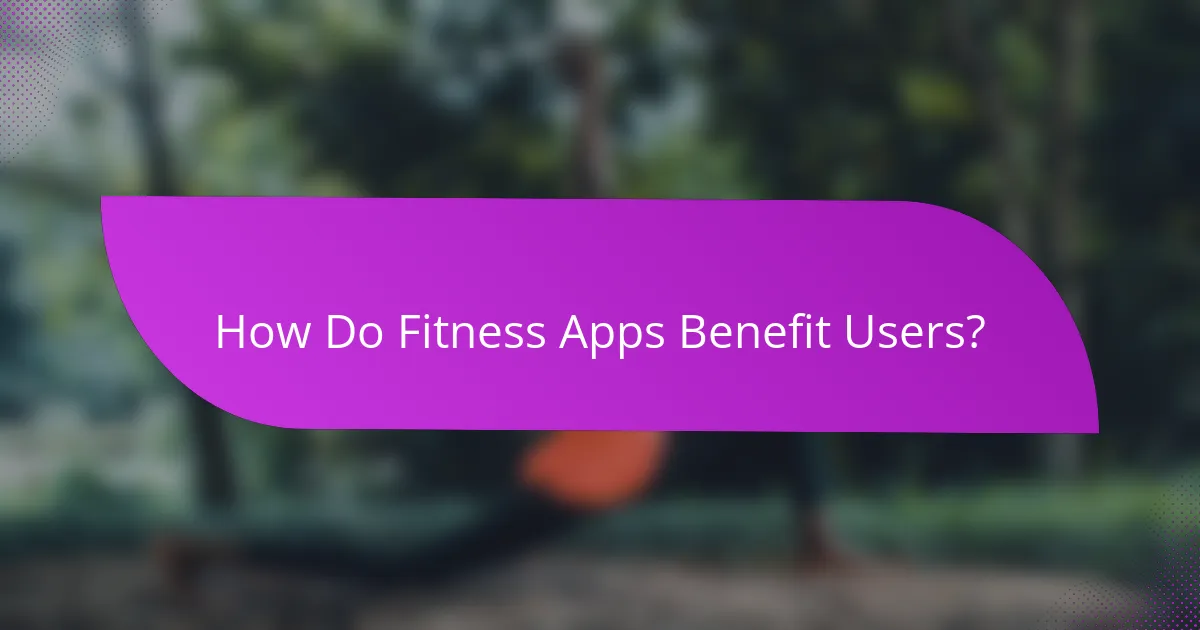
How Do Fitness Apps Benefit Users?
Fitness apps provide users with a range of benefits that enhance their workout experience and overall health. These applications help individuals stay motivated, create personalized workout plans, track their progress, and connect with a supportive community.
Improved Motivation
Fitness apps boost motivation by offering features like goal setting and reminders. Users can set specific fitness targets, such as running a certain distance or completing a number of workouts each week, which encourages consistency.
Gamification elements, such as earning badges or competing with friends, can further enhance motivation. For example, some apps allow users to challenge friends to complete workouts, making fitness more engaging and fun.
Personalized Workouts
Many fitness apps provide personalized workout plans tailored to individual fitness levels and goals. Users can input their preferences, such as workout duration and type, to receive customized routines that suit their needs.
Some apps utilize algorithms to adjust workouts based on user performance, ensuring that the exercises remain challenging yet achievable. This adaptability helps users progress effectively while minimizing the risk of injury.
Progress Tracking
Fitness apps enable users to track their progress over time, which is crucial for achieving fitness goals. Users can log workouts, monitor calories burned, and track metrics like weight or body measurements.
Visual representations, such as graphs and charts, help users see their improvements, making it easier to stay committed. Regularly reviewing progress can motivate users to push harder and celebrate their achievements.
Community Support
Community features in fitness apps foster a sense of belonging and support among users. Many apps include social platforms where users can share their experiences, tips, and challenges, creating a network of encouragement.
Participating in community challenges or group workouts can enhance accountability and motivation. Users often find that connecting with others who share similar fitness goals helps them stay engaged and committed to their routines.
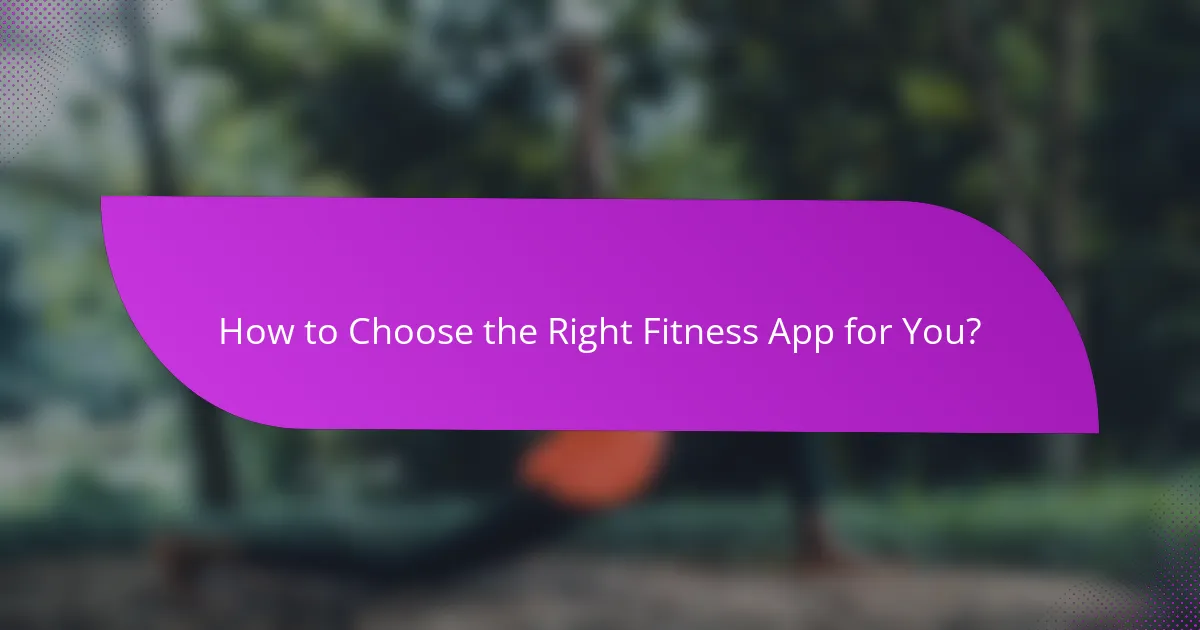
How to Choose the Right Fitness App for You?
Choosing the right fitness app involves understanding your personal fitness goals, the app’s user interface, device compatibility, and subscription costs. By evaluating these factors, you can select an app that best fits your lifestyle and needs.
Assess Your Goals
Start by identifying what you want to achieve with a fitness app. Whether your goals include weight loss, muscle gain, or improving endurance, different apps cater to specific objectives. For example, some apps focus on strength training, while others emphasize cardio or flexibility.
Consider setting measurable targets, such as losing a certain number of kilograms or running a specific distance. This clarity will help you choose an app that offers the right features, such as workout plans or progress tracking, to support your journey.
Consider User Interface
The user interface (UI) of a fitness app significantly impacts your experience. A clean, intuitive design makes it easier to navigate and stay motivated. Look for apps that offer customizable dashboards, clear navigation, and engaging visuals.
Try out a few apps to see which UI resonates with you. Many apps provide free trials, allowing you to assess usability before committing. A user-friendly interface can enhance your overall engagement and adherence to your fitness routine.
Check Compatibility with Devices
Ensure the fitness app you choose is compatible with your devices, such as smartphones, tablets, or smartwatches. Some apps may only function on specific operating systems, like iOS or Android, which can limit your options.
Additionally, consider whether the app integrates with other fitness devices or wearables you own, such as heart rate monitors or fitness trackers. This compatibility can provide a more comprehensive view of your fitness data and enhance your workout experience.
Evaluate Subscription Costs
Most fitness apps operate on a subscription model, with costs varying widely. Some apps offer free versions with limited features, while premium subscriptions can range from a few dollars to over twenty dollars per month. Assess what features are included in each pricing tier to determine value.
Look for apps that offer a money-back guarantee or free trials, allowing you to test the app before committing financially. Be cautious of hidden fees or automatic renewals that can increase your overall costs unexpectedly.
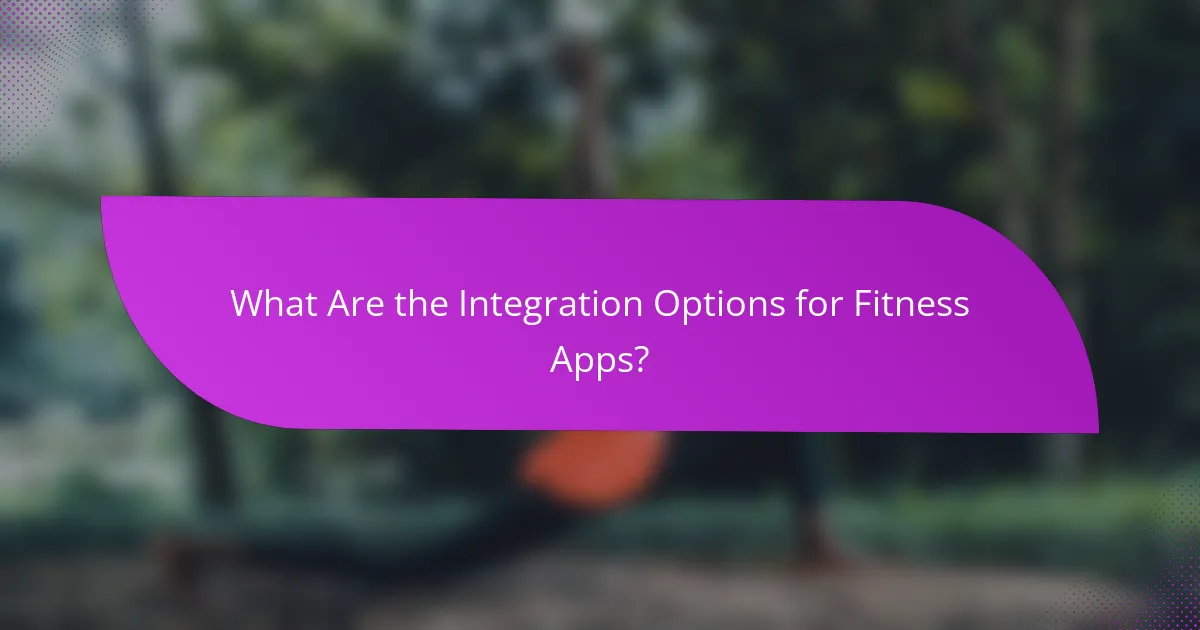
What Are the Integration Options for Fitness Apps?
Fitness apps offer various integration options that enhance user experience and functionality. These integrations typically include wearable devices, health platforms, and social media, allowing users to track their fitness journey comprehensively.
Wearable Devices
Wearable devices, such as smartwatches and fitness trackers, are essential for fitness app integration. They collect real-time data on metrics like heart rate, steps, and calories burned, which can be synced with fitness applications for a more accurate overview of health and activity levels.
When choosing a wearable device, consider compatibility with your preferred fitness app. Popular options include devices from brands like Fitbit, Garmin, and Apple, which often support multiple fitness applications. Ensure that the device you select can seamlessly connect to your app of choice to avoid data discrepancies.
To maximize the benefits of wearable integration, regularly check for software updates and sync your device with the app. This practice ensures that you have access to the latest features and improvements, enhancing your overall fitness tracking experience.

